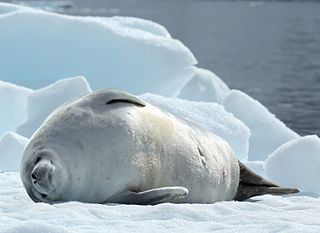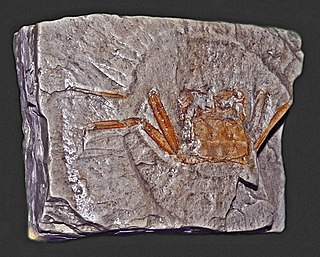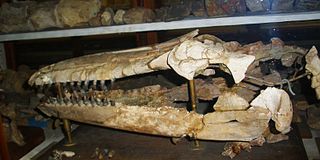The Pliocene Epoch is the epoch in the geologic timescale that extends from 5.333 million to 2.58 million years BP. It is the second and most recent epoch of the Neogene Period in the Cenozoic Era. The Pliocene follows the Miocene Epoch and is followed by the Pleistocene Epoch. Prior to the 2009 revision of the geologic time scale, which placed the four most recent major glaciations entirely within the Pleistocene, the Pliocene also included the Gelasian Stage, which lasted from 2.588 to 1.806 million years ago, and is now included in the Pleistocene.
Tertiary is a widely used but obsolete term for the geologic period from 66 million to 2.6 million years ago. The period began with the demise of the non-avian dinosaurs in the Cretaceous–Paleogene extinction event, at the start of the Cenozoic Era, and extended to the beginning of the Quaternary glaciation at the end of the Pliocene Epoch. The time span covered by the Tertiary has no exact equivalent in the current geologic time system, but it is essentially the merged Paleogene and Neogene Periods, which are informally called the Lower Tertiary and the Upper Tertiary, respectively.

An auk or alcid is a bird of the family Alcidae in the order Charadriiformes. The alcid family includes the murres, guillemots, auklets, puffins, and murrelets. The word auk is derived from Icelandic álka, from Old Norse alka (“auk”), from Proto-Germanic *alkǭ.

The crabeater seal, also known as the krill-eater seal, is a true seal with a circumpolar distribution around the coast of Antarctica. They are medium- to large-sized, relatively slender and pale-colored, found primarily on the free-floating pack ice that extends seasonally out from the Antarctic coast, which they use as a platform for resting, mating, social aggregation and accessing their prey. They are by far the most abundant seal species in the world. While population estimates are uncertain, there are at least 7 million and possibly as many as 75 million individuals. This success of this species is due to its specialized predation on the abundant Antarctic krill of the Southern Ocean, for which it has uniquely adapted, sieve-like tooth structure. Indeed, its scientific name, translated as "lobe-toothed (lobodon) crab eater (carcinophaga)", refers specifically to the finely lobed teeth adapted to filtering their small crustacean prey. Despite its name, crabeater seals do not eat crabs. As well as being an important krill predator, the crabeater seal's pups are an important component of the diet of leopard seals, which are responsible for 80% of all crabeater pups deaths.

The Japanese spider crab is a species of marine crab that lives in the waters around Japan. It has the largest leg span of any arthropod. They go through three main larval stages along with a prezoeal stage in order to grow to their great size. The genus Macrocheira contains multiple species. Two fossil species of this genus have been found, Macrocheira ginzanensis and Macrocheira yabei, both from the Miocene of Japan. The diverse taxonomic history is an important part of what these creatures are and how they evolved to be what they are today. They are sought by Crab fisheries, and are considered a delicacy in Japan. Conservation efforts are being put forth to protect these creatures and their population from the dangers of overfishing. The Japanese spider crab is similar in appearance to the much smaller European spider crab (Maja squinado) and is not to be confused with it.

Horseshoe crabs are marine and brackish water arthropods of the family Limulidae, and the only living members of the order Xiphosura. Their popular name is a misnomer, as they are not true crabs, nor even crustaceans, as crabs are, but are chelicerates, most closely related to arachnids.

The crab-eating fox, also known as the forest fox, wood fox, bushdog or maikong, is an extant species of medium-sized canid endemic to the central part of South America, and which appeared during the Pliocene epoch. Like South American foxes, which are in the genus Lycalopex, it is not closely related to true foxes. Cerdocyon comes from the Greek words kerdo and kyon (dog) referring to the dog- and fox-like characteristics of this animal.

Cancer is a genus of marine crabs in the family Cancridae. It includes eight extant species and three extinct species, including familiar crabs of the littoral zone, such as the European edible crab, the Jonah crab and the red rock crab. It is thought to have evolved from related genera in the Pacific Ocean in the Miocene.

Metacarcinus anthonyi, the yellow rock crab or yellow crab, is a species of edible crab native to the Pacific coast of North America.

Craveri's murrelet is a small seabird which breeds on offshore islands in both the Pacific Ocean and the Gulf of California off the Baja peninsula of Mexico. It also wanders fairly regularly as far as central California in the US, primarily during post-breeding dispersal. It is threatened by predators introduced to its breeding colonies, by oil spills, and by tanker traffic. Increasing tourism development and commercial fishing fleets also further threaten the species. With an estimated population of 6,000-10,000 breeding pairs, its population is listed as vulnerable.

Lobocarcinus is a genus of extinct marine crabs that lived in the Eocene through Pliocene, containing these species:

Retroplumidae is a family of heterotrematan crabs, placed in their own (monotypic) superfamily, Retroplumoidea.

Paracamelus is an extinct genus of camel in the family Camelidae. It originated in North America during the Middle Miocene but crossed the Beringian land bridge into Eurasia during the Late Miocene, approximately 7.5–6.5 million years ago (Ma); its later range spanned from Spain and Italy to Chad and Shanxi Province, China. It is ancestral to living camels of the genus Camelus. A population remained in northern North America, which became the high Arctic camel, which survived until the Middle Pleistocene approximately 1 Ma.

Metacarcinus is a genus of crabs formerly included in the genus Cancer. It includes nine exclusively fossil species and five extant species, of which four are also known from the fossil record. The monophyly of this genus was not supported by a molecular study using the cytochrome oxidase I gene.

Hemisyntrachelus is an extinct genus of cetacean.

Federico Craveri was an Italian explorer, ethnographer, geologist, meteorologist and naturalist noted for his studies in Mexico.

Retropluma is a genus of heterotrematan crabs belonging to the family Retroplumidae. The extant species survive in the deep sea of the Indo-Pacific region.

Galene is a genus of crabs belonging to the family Galenidae
Pachyacanthus is an extinct genus of toothed whale that lived about 15.97 to 2.589 million years ago. It contains the single species Pachyacanthus suessi. The genus is known from European deposits in Hungary, Kazakhstan, Austria and Italy. The type specimen consisted of a few fragments of a rostrum and two fragmentary tympanic bullae. Skeletons from the Sarmatian of Austria did not include skulls.
Casatia is a genus of extinct cetacean from the Early Pliocene, approximately between 5.1 and 4.5 million years ago. The genus contains a single species, C. thermophila. It was described from a partial skull. Its closest relatives are the narwhal and beluga, yet the remains were found farther south than its relatives, supporting the theory that monodontids evolved from warm water genera before becoming adapted to cold water.















